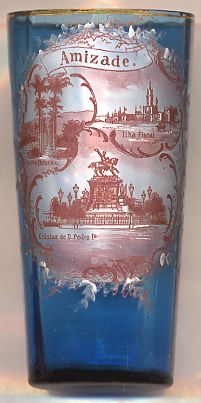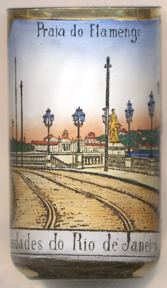

|
| BRASIL | BRAZIL |
| estado: Rio de Janeiro |
Rio de Janeiro is the capital city of the State of Rio de Janeiro, the second largest city of Brazil, and the third largest metropolitan area and agglomeration in South America. The city was the capital of Brazil for nearly two centuries, from 1763 to 1822 during the Portuguese colonial era, and from 1822 to 1960 as an independent nation. It is also the former capital of the Portuguese Empire. Commonly known as just Rio, the city is also nicknamed A Cidade Maravilhosa or “The Marvelous City”. Rio de Janeiro is famous for its natural settings, its carnival celebrations and hotel-lined tourist beaches, such as Copacabana, Ipanema and Leblon. Some of the most famous landmarks in addition to the beaches include the giant statue of Christ, known as Christ the Redeemer (‘Cristo Redentor’) atop Corcovado mountain; Sugarloaf mountain (Pão de Açúcar) with its cable car; the Sambódromo, a giant permanent parade avenue lined with grandstands which is used during Carnival; and Maracanã stadium, one of the world's largest football stadiums. Rio de Janeiro hosted the 2016 Summer Olympics, and was the first South American city to host the event. Since 2012, Rio de Janeiro has been inscribed as a UNESCO World Heritage Site for its arts, urban culture and designed landscapes set around a natural environment (see also list of other UNESCO heritage sites depicted on glasses of this collection).
Europeans first encountered Guanabara Bay on January 1, 1502 (hence Rio de Janeiro, “January River”) by a Portuguese expedition under
explorer Gaspar de Lemos who was a captain of a ship in Pedro Álvares Cabral's fleet. Allegedly the Florentine explorer Amerigo Vespucci
participated as observer at the invitation of King Manuel I in the latter's expedition. The region of Rio was inhabited by the Tupi, Puri, Botocudo
and Maxakalí peoples. The city of Rio de Janeiro proper was founded on March 1, 1565. Until early in the 18th century, the city was
threatened or invaded by several, mostly French, pirates and buccaneers. In the late 17th century, still during the Sugar Era, the Bandeirantes
found gold and diamonds in the neighbouring captaincy of Minas Gerais, thus Rio de Janeiro became a much more practical port for exporting wealth (gold,
precious stones, besides the sugar) than Salvador, Bahia, which is much farther to the northeast.
And so in 1763, the colonial administration in Portuguese America was moved from Salvador to Rio de Janeiro. The city remained primarily a colonial capital
until 1808, when the Portuguese royal family under Dom João VI (regent for his mother Dona Maria I) and most of the associated
Lisbon nobles, fleeing from Napoleon's invasion of Portugal, moved to Rio de Janeiro. The kingdom's capital was transferred to
the city, which, thus, became the only European capital outside of Europe. In 1821 the Royal Family moved back to Portugal, leaving the Prince Dom
Pedro I to rule the colony. In 1822, after rebelling against orders to return to Portugal, Dom Pedro I declared Brazil independent from Portugal,
and became the first Emperor of Brazil. Rio continued as the capital of Brazil after 1889, when the monarchy was replaced by a republic. Plans for moving
the nation's capital city to the territorial centre had been occasionally discussed, and when Juscelino Kubitschek was elected president in 1955, it was
partially on the strength of promises to build a new capital. Kubitschek managed to have Brasília built, at great cost, by 1960. On April 21
that year the capital of Brazil was officially moved from Rio de Janeiro to Brasília. Between 1960 and 1975 Rio was a city-state under the name
State of Guanabara. However, for administrative and political reasons, a presidential decree known as “The Fusion” removed the city's
federative status and merged it with the State of Rio de Janeiro in 1975.
[Text adapted from http://en.wikipedia.org/wiki/Rio_de_Janeiro; http://worldfacts.us/Brazil-Rio-De-Janeiro.htm]

The  Rio de Janeiro Botanical Garden or Jardim Botânico [top left picture] was founded in 1808 by Dom João VI (regent of Portugal; 1816 King of Portugal and Brasil).
It is located in the Jardim Botânico district in the “Zona Sul” (South Zone) of the city. Originally intended for the acclimatization of spices like nutmeg, pepper and cinnamon
imported from the West Indies, the Garden was opened to the public in 1822, and is now open during daylight hours every day except 25 December and 1 January.
The 140-hectare park lies at the foot of the Corcovado Mountain, far below the right arm of the statue of Christ the Redeemer and contains more than 6,000 different species
of tropical and subtropical plants and trees, including 900 varieties of palm trees. A 750 m line of 134 palms forms the Avenue of Royal Palms leads from the entrance
into the gardens. These palms are descended from a single tree, the Palma Mater, long since destroyed by lightning. Only about 40% of the park is cultivated, the remainder
being Atlantic Forest rising up the slopes of Corcovado. The park is protected by the Patrimônio Histórico e Artístico Nacional and was designated as a biosphere reserve by
UNESCO in 1992.
Rio de Janeiro Botanical Garden or Jardim Botânico [top left picture] was founded in 1808 by Dom João VI (regent of Portugal; 1816 King of Portugal and Brasil).
It is located in the Jardim Botânico district in the “Zona Sul” (South Zone) of the city. Originally intended for the acclimatization of spices like nutmeg, pepper and cinnamon
imported from the West Indies, the Garden was opened to the public in 1822, and is now open during daylight hours every day except 25 December and 1 January.
The 140-hectare park lies at the foot of the Corcovado Mountain, far below the right arm of the statue of Christ the Redeemer and contains more than 6,000 different species
of tropical and subtropical plants and trees, including 900 varieties of palm trees. A 750 m line of 134 palms forms the Avenue of Royal Palms leads from the entrance
into the gardens. These palms are descended from a single tree, the Palma Mater, long since destroyed by lightning. Only about 40% of the park is cultivated, the remainder
being Atlantic Forest rising up the slopes of Corcovado. The park is protected by the Patrimônio Histórico e Artístico Nacional and was designated as a biosphere reserve by
UNESCO in 1992.
[Text adapted from http://en.wikipedia.org/wiki/Rio_de_Janeiro_Botanical_Garden]
 Ilha Fiscal [top right picture] is located within the Guanabara Bay, bordered to the historic city of Rio de Janeiro in Brazil.
Originally named by Europeans as ‘Island of the Rat’, its current name comes from the fact that it had been the location of the office of the Fiscal Guard, which served
the port of the then capital of the Empire in the nineteenth century. The island became famous for having housed the famous ball on Ilha Fiscal, the last big party of the
Empire before the proclamation of the Republic, in November 1889. The gothic palace on Ilha Fiscal was built in 1889 at the Dom Pedro II's request. Once home to the
Customs Service, it is now a naval museum, with stained glass windows that recount the history of the Brazilian royal family.
Ilha Fiscal [top right picture] is located within the Guanabara Bay, bordered to the historic city of Rio de Janeiro in Brazil.
Originally named by Europeans as ‘Island of the Rat’, its current name comes from the fact that it had been the location of the office of the Fiscal Guard, which served
the port of the then capital of the Empire in the nineteenth century. The island became famous for having housed the famous ball on Ilha Fiscal, the last big party of the
Empire before the proclamation of the Republic, in November 1889. The gothic palace on Ilha Fiscal was built in 1889 at the Dom Pedro II's request. Once home to the
Customs Service, it is now a naval museum, with stained glass windows that recount the history of the Brazilian royal family.
[Text adapted from http://pt.wikipedia.org/wiki/Ilha_Fiscal; http://www.whatsonwhen.com/sisp/index.htm?fx=event&event_id=183850]
The  equestrian monument for Dom Pedro I [bottom picture] is located in Tiradentes Square, also known as Constitution Square.
The monument, erected in 1862, was the first civic monument in Rio de Janeiro. The sculpture features the emperor on horseback. Around the base are four figures in bronze,
representing Brazil's four major rivers: Amazonas, Madeira, São Francisco and Paraná. The sculpture was designed by João Maximiniano Mafra, a painter and professor
at the Imperial Academy of Fine Arts, and executed in France by the French sculptor Louis Rochet.
equestrian monument for Dom Pedro I [bottom picture] is located in Tiradentes Square, also known as Constitution Square.
The monument, erected in 1862, was the first civic monument in Rio de Janeiro. The sculpture features the emperor on horseback. Around the base are four figures in bronze,
representing Brazil's four major rivers: Amazonas, Madeira, São Francisco and Paraná. The sculpture was designed by João Maximiniano Mafra, a painter and professor
at the Imperial Academy of Fine Arts, and executed in France by the French sculptor Louis Rochet.
[Text adapted from http://www.wdl.org/en/item/1613; http://www.1911encyclopedia.org/Rio_De_Janeiro,_Brazil; http://pt.wikipedia.org/wiki/Est%C3%A1tua_equestre_de_D._Pedro_I]

The  Praia do Flamengo ('beach of the Flemish') [near left, no. 2563] is located on the edge of
Guanabara Bay, between the Catete and Botafogo districts of Rio de Janeiro. It was given this name as it was the place where the Dutch merchant captain
Olivier van Noort tried to invade the city in 1599 (at that time, the Dutchmen were called 'Flemish' by the Portuguese).
Praia do Flamengo ('beach of the Flemish') [near left, no. 2563] is located on the edge of
Guanabara Bay, between the Catete and Botafogo districts of Rio de Janeiro. It was given this name as it was the place where the Dutch merchant captain
Olivier van Noort tried to invade the city in 1599 (at that time, the Dutchmen were called 'Flemish' by the Portuguese).
[https://en.wikipedia.org/wiki/Flamengo,_Rio_de_Janeiro]
![[scale]](lineal.jpg)